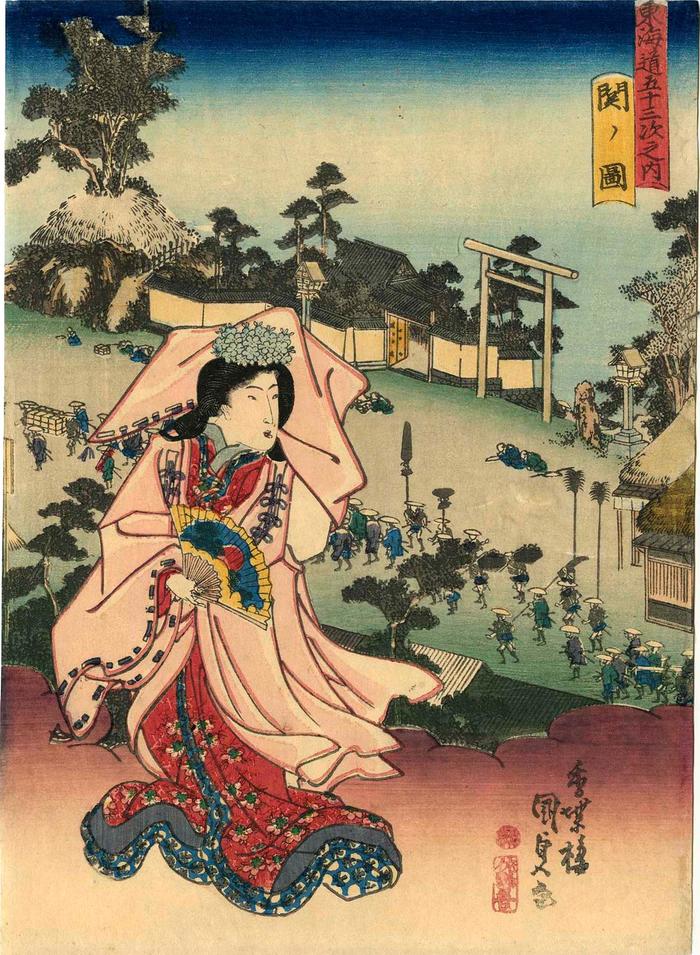Utagawa Kunisada (歌川国貞) / Toyokuni III (三代豊国) (artist 1786 – 01/12/1865)
View of Seki (Seki no zu: 関ノ図) from the chuban series Fifty-three Stations of the Tōkaidō Road (Tōkaidō gojūsan tsugi no uchi: 東海道五十三次之内)
ca 1838
Signed: Kōchōrō Kunisada ga (香蝶楼国貞画)
Publisher: Sanoya Kihei
Censor's seal: kiwame
Museum of Fine Arts, Boston
Honolulu Museum of Art
Museum für angewandte Kunst, Vienna
National Diet Library
Spencer Museum of Art
Fujisawa Ukiyo-e Museum
Östasiatiska Museet, Stockholm
Ishikawa Prefectural Museum of Art - they date their copy to 1836
Bryn Mawr
Honolulu Museum of Art
Östasiatiska museet, Stockholm
Berkeley Art Museum and Pacific Film Archive at the University of California In Hokusai and Hiroshige: Great Japanese Prints from the James A. Michener Collection, Honolulu Academy of Arts on page 213 it says: "Seki was situated on the Tōkaidō Road at the foot of the Suzuka Mountains, where two roads branched off to Ise and Yamato. The governmental barrier or checkpoint (seki) situated there in former times gave the town its name."
****
This is number 48 in the series. The curatorial files at Museum für angewandte Kunst in Vienna say: "The picture of the Seki 関 station in the background was thought up by Kunisada himself and shows a daimyō train (daimyō gyōretsu 大名 行列) crossing the place. In the background a torii 鳥 居 that leads to a shrine. In the foreground a miko (shrine priestess) with a fan."
****
Kunisada did not use Hiroshige's Seki print as a template. However, they do have one thing in common in that they both relate to a daimyo's procession. There was a honjin or large inn, one large enough to accommodate a daimyo's retinue. Perhaps this is the building seen in the lower right of the Kunisada, perhaps not.
****
In Hiroshige: l'art du voyage, Paris, 2012, p. 93 they point out that this location on the Tōkaidō met up with the road to Ise. There were two large inns or honjin (本陣) large enough to accommodate a daimyō's retinue. It is also noted that in the Hiroshige print, not shown here, there are two subtle placements of the logos for two major perfumers. They probably underwrote the production of this print and thus were able to promote their products in a most subtle way.
****
The term 'seki' (関) can mean barrier, gate or checkpoint. Muneshige Narazaki in Masterworks of Ukiyo-e: Hiroshige, the 53 Stations of the Tōkaidō (p. 81) noted: "Since prosperous travelers stopped at Seki, it was famous for its large number of prostitutes."
****
Illustrated in a small color reproduction in Kunisada's Tokaido: Riddles in Japanese Woodblock Prints by Andreas Marks, Hotei Publishing, 2013, page 74, T24-48.
Sanoya Kihei (佐野屋喜兵衛) (publisher)
landscape prints (fūkeiga 風景画) (genre)
